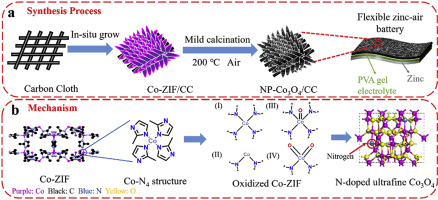Energy Storage Materials ( IF 20.4 ) Pub Date : 2019-12-31 , DOI: 10.1016/j.ensm.2019.12.043 Xia Wang , Zhongquan Liao , Yubin Fu , Christof Neumann , Andrey Turchanin , Gyutae Nam , Ehrenfried Zschech , Jaephil Cho , Jian Zhang , Xinliang Feng

|
Cobalt oxides are promising bifunctional oxygen electrocatalysts due to their intrinsic activities toward both dissociation and formation of oxygen molecules. Unfortunately, their practical utilization is seriously hindered by the limited accessible active sites and inferior activity. Herein, vertically-aligned porous nanoarrays composed of ultrafine nitrogen-doped cobalt oxide (NP-Co3O4) nanoparticles (4-5 nm) are in-situ fabricated on carbon cloth (CC) via mild oxidation of Co-based zeolitic-imidazolate-framework (Co-ZIF) nanoarrays. The oxidation decomposition of 2-methylimidazolate ligands between Co nodes not only confines the growth of cobalt oxides, but also provides the nitrogen sources for realizing low-temperature (200 oC) nitrogen doping. In alkaline electrolyte, the as-built NP-Co3O4/CC manifests an extremely high oxygen reduction reaction (ORR) half-wave potential of ∼0.9 V and a decreased oxygen evolution reaction (OER) overpotential of 330 mV at 10 mA cm-2, displaying a record low potential gap of 0.66 V. As bifunctional oxygen electrodes in rechargeable aqueous and all-solid-state flexible zinc-air batteries, the NP-Co3O4/CC-based batteries exhibit ultrahigh power densities up to 200 mW cm-2 and 99.8 mW cm-3, respectively, which are much higher than those of reported bifunctional oxygen electrocatalysts. This work paves a new avenue for the fabrication of porous nitrogen doped metal oxides towards high-performance zinc-air batteries.
中文翻译:

作为可充锌空气电池的双功能氧气电化学催化剂,多孔氮掺杂氧化钴纳米阵列的局限性生长
氧化钴因其对氧分子的解离和形成的固有活性而有望成为双功能氧电催化剂。不幸的是,由于有限的可访问的活性位点和次等活性,严重阻碍了它们的实际利用。本文中,通过对钴基沸石分子筛进行轻度氧化,在碳布(CC)上原位制作了由超细氮掺杂氧化钴(NP-Co 3 O 4)纳米粒子(4-5 nm)组成的垂直排列的多孔纳米阵列。咪唑啉骨架(Co-ZIF)纳米阵列。Co节点之间的2-甲基咪唑盐配体的氧化分解不仅限制了氧化钴的生长,而且为实现低温(200 oC)氮掺杂。在碱性电解液中,已建成的NP-Co 3 O 4 / CC在10 mA下表现出极高的氧还原反应(ORR)半波电势,约为0.9 V,而氧释放反应(OER)的超电势降低了330 mV。 cm -2,显示出创纪录的0.66 V的低电势差。NP-Co 3 O 4 / CC基电池作为可再充电的水性和全固态柔性锌-空气电池中的双功能氧电极,具有超高的功率密度至200 mW cm -2和99.8 mW cm -3分别比报道的双功能氧电催化剂要高得多。这项工作为高性能的锌-空气电池制造了多孔氮掺杂金属氧化物的制造开辟了一条新途径。


























 京公网安备 11010802027423号
京公网安备 11010802027423号